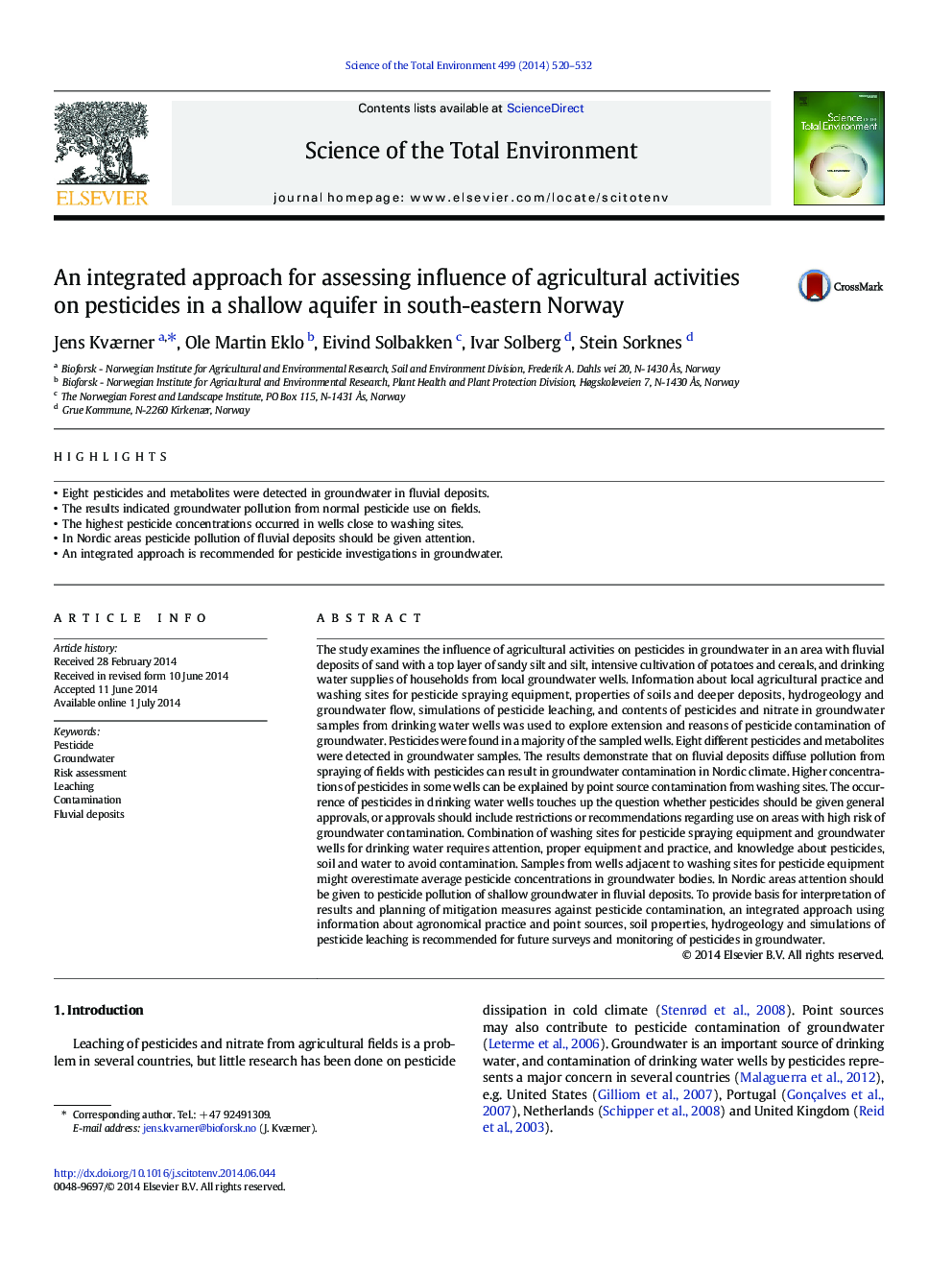| کد مقاله | کد نشریه | سال انتشار | مقاله انگلیسی | نسخه تمام متن |
|---|---|---|---|---|
| 6328974 | 1619774 | 2014 | 13 صفحه PDF | دانلود رایگان |
عنوان انگلیسی مقاله ISI
An integrated approach for assessing influence of agricultural activities on pesticides in a shallow aquifer in south-eastern Norway
ترجمه فارسی عنوان
یک رویکرد یکپارچه برای ارزیابی تأثیر فعالیت های کشاورزی بر آفت کش ها در یک آبخیز کم عمق در جنوب شرقی نروژ
دانلود مقاله + سفارش ترجمه
دانلود مقاله ISI انگلیسی
رایگان برای ایرانیان
کلمات کلیدی
آفت کش ها، آب های زیرزمینی، ارزیابی ریسک، شستن آلودگی، رسوبات رشته ای،
ترجمه چکیده
این مطالعه به بررسی تأثیر فعالیت های کشاورزی بر آفت کش ها در آب های زیرزمینی در ناحیه ای با رسوب های رگبار شن و ماسه با لایه ای از گرده ماسه ای و سیل، کشت شدید سیب زمینی و غلات و تامین آب آشامیدنی خانوار از چاه های آب زیرزمینی محلی می پردازد. اطلاعات در مورد مکان های کشاورزی محلی و محل های شستشو برای تجهیزات آبیاری آفت کش، ویژگی های خاک و رسوبات عمیق، هیدروژئولوژی و جریان آب های زیرزمینی، شبیه سازی شستشوی آفت کش ها و محتویات آفت کش ها و نیترات در نمونه های آب زیرزمینی از چاه های آب آشامیدنی برای کشف گسترش و دلایل آلودگی آبهای زیرزمینی آفت کش ها. آفت کش ها در اکثر چاه های نمونه ای یافت می شوند. هشت آفت کش و متابولیت های مختلف در نمونه های آب زیرزمینی شناسایی شدند. نتایج نشان می دهد که در رسوبات فاضلاب انتشار آلودگی از اسپری مناطق با آفت کش ها می تواند آلودگی آب های زیرزمینی را در آب و هوای شمال اروپا منجر شود. غلظت بیشتر از آفت کش ها در برخی از چاه ها می تواند با آلودگی نقطه ای از محل های شستشو توضیح داده شود. وقوع آفت کش ها در چاه های آب آشامیدنی مسئله این است که آیا آفت کش ها باید به تصویب عمومی واگذار شود یا تصویب باید حاوی محدودیت ها یا توصیه هایی در مورد استفاده در مناطقی با خطر بالای آلودگی آب های زیرزمینی باشد. ترکیبی از مکان های شستشو برای تجهیزات آبیاری آفت کش ها و چاه های آب زیرزمینی برای آب آشامیدنی نیاز به توجه، تجهیزات و عملیات مناسب و دانش در مورد آفت کش ها، خاک و آب برای جلوگیری از آلودگی دارد. نمونه هایی از چاه های مجاور به مکان های شستشو برای تجهیزات آفت کش ممکن است به طور متوسط غلظت آفت کش ها در بدن های زیرزمینی بیش از حد باشد. در مناطق شمال اروپا توجه به آلودگی آفت کش های زیرزمینی آب های زیرزمینی در رسوبات ریخته گری باید توجه شود. برای فراهم آوردن مبنایی برای تفسیر نتایج و برنامه ریزی اقدامات کاهش در برابر آلودگی آفت کش، یک روش یکپارچه با استفاده از اطلاعات در مورد عمل زراعی و منابع نقطه ای، خواص خاک، هیدروژئولوژی و شبیه سازی شستشوی آفت کش ها برای بررسی های آینده و نظارت بر آفت کش ها در آبهای زیرزمینی توصیه می شود.
موضوعات مرتبط
علوم زیستی و بیوفناوری
علوم محیط زیست
شیمی زیست محیطی
چکیده انگلیسی
The study examines the influence of agricultural activities on pesticides in groundwater in an area with fluvial deposits of sand with a top layer of sandy silt and silt, intensive cultivation of potatoes and cereals, and drinking water supplies of households from local groundwater wells. Information about local agricultural practice and washing sites for pesticide spraying equipment, properties of soils and deeper deposits, hydrogeology and groundwater flow, simulations of pesticide leaching, and contents of pesticides and nitrate in groundwater samples from drinking water wells was used to explore extension and reasons of pesticide contamination of groundwater. Pesticides were found in a majority of the sampled wells. Eight different pesticides and metabolites were detected in groundwater samples. The results demonstrate that on fluvial deposits diffuse pollution from spraying of fields with pesticides can result in groundwater contamination in Nordic climate. Higher concentrations of pesticides in some wells can be explained by point source contamination from washing sites. The occurrence of pesticides in drinking water wells touches up the question whether pesticides should be given general approvals, or approvals should include restrictions or recommendations regarding use on areas with high risk of groundwater contamination. Combination of washing sites for pesticide spraying equipment and groundwater wells for drinking water requires attention, proper equipment and practice, and knowledge about pesticides, soil and water to avoid contamination. Samples from wells adjacent to washing sites for pesticide equipment might overestimate average pesticide concentrations in groundwater bodies. In Nordic areas attention should be given to pesticide pollution of shallow groundwater in fluvial deposits. To provide basis for interpretation of results and planning of mitigation measures against pesticide contamination, an integrated approach using information about agronomical practice and point sources, soil properties, hydrogeology and simulations of pesticide leaching is recommended for future surveys and monitoring of pesticides in groundwater.
ناشر
Database: Elsevier - ScienceDirect (ساینس دایرکت)
Journal: Science of The Total Environment - Volume 499, 15 November 2014, Pages 520-532
Journal: Science of The Total Environment - Volume 499, 15 November 2014, Pages 520-532
نویسندگان
Jens Kværner, Ole Martin Eklo, Eivind Solbakken, Ivar Solberg, Stein Sorknes,
